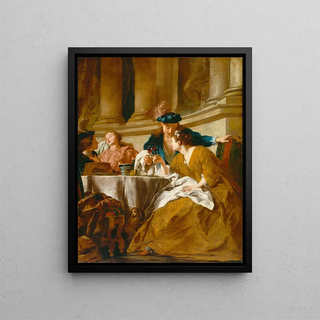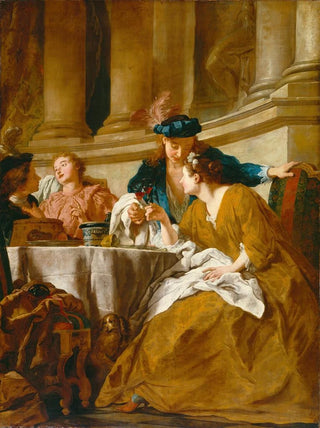Art print | Luncheon with Costumed Characters - Jean-François de Troy School


View from behind

Frame (optional)
The scene depicted in "L Déjeuner avec des personnages en costumes de mascarade" transports the viewer into a universe where reality and dream intertwine with finesse. The characters, dressed in flamboyant costumes, seem to emerge from a masked ball, evoking an atmosphere of mystery and elegance. This work, emblematic of the École de Jean-François de Troy, invites us to explore the subtleties of social life in the 18th century, while revealing the play of light and color that characterizes the style of the period. The art print of this piece allows not only for admiration of the artist's technical virtuosity but also for immersion in a suspended moment, rich in emotions and stories to tell.
Style and uniqueness of the work
The style of Jean-François de Troy is distinguished by remarkable delicacy and meticulous attention to detail. In this work, each character is carefully depicted, from the sumptuous drapes of their costumes to facial expressions that betray a range of emotions. The vivid colors and subtle contrasts create a captivating dynamic, drawing the eye to the various interactions taking place on the canvas. The choice of poses and gestures of the characters reinforces the idea of a shared moment, of a festive conviviality. Through this déjeuner scene, the artist does not merely depict a moment of life but also captures the spirit of an era where refinement and sociability were essential values.
The artist and his influence
Jean-François de Troy, an emblematic figure of the 18th century, managed to leave his mark on his era through his innovative approach to painting. Raised in an artistic environment, he was influenced by the great masters of his time while developing his own style. His work demonstrates a deep understanding of the social and aesthetic codes of his period, which allowed him to carve out a unique place in art history. By incorporating elements of daily life into his works, he paved the way for a new way of viewing painting, where the everyday and the sublime coexist harmoniously. His influence endures today, inspiring many

Matte finish

View from behind

Frame (optional)
The scene depicted in "L Déjeuner avec des personnages en costumes de mascarade" transports the viewer into a universe where reality and dream intertwine with finesse. The characters, dressed in flamboyant costumes, seem to emerge from a masked ball, evoking an atmosphere of mystery and elegance. This work, emblematic of the École de Jean-François de Troy, invites us to explore the subtleties of social life in the 18th century, while revealing the play of light and color that characterizes the style of the period. The art print of this piece allows not only for admiration of the artist's technical virtuosity but also for immersion in a suspended moment, rich in emotions and stories to tell.
Style and uniqueness of the work
The style of Jean-François de Troy is distinguished by remarkable delicacy and meticulous attention to detail. In this work, each character is carefully depicted, from the sumptuous drapes of their costumes to facial expressions that betray a range of emotions. The vivid colors and subtle contrasts create a captivating dynamic, drawing the eye to the various interactions taking place on the canvas. The choice of poses and gestures of the characters reinforces the idea of a shared moment, of a festive conviviality. Through this déjeuner scene, the artist does not merely depict a moment of life but also captures the spirit of an era where refinement and sociability were essential values.
The artist and his influence
Jean-François de Troy, an emblematic figure of the 18th century, managed to leave his mark on his era through his innovative approach to painting. Raised in an artistic environment, he was influenced by the great masters of his time while developing his own style. His work demonstrates a deep understanding of the social and aesthetic codes of his period, which allowed him to carve out a unique place in art history. By incorporating elements of daily life into his works, he paved the way for a new way of viewing painting, where the everyday and the sublime coexist harmoniously. His influence endures today, inspiring many






